




ORION KIM
co-EDITOR IN CHIEF
A blaring fire siren pierces the air, another drill that has become routine on campus. Students and teachers chatter in the Huss parking lot, unbothered by what has become a formality.
While fire drills are a common occurrence at school, there are many other safety practices and precautions that students know little about. Themes will include fire safety, severe weather, talking with trusted adults, closed campus and active threats.
Director of Operations and Security John Cole has worked to launch a pilot program. This initiative, named Community Partnership Month, has a goal to inform the school about important precautions.
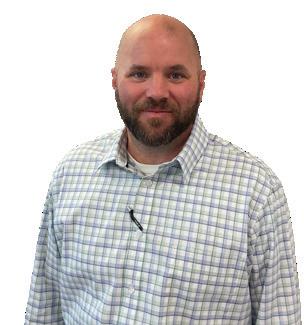
“It’s a program to hopefully ensure that our entire community—students, faculty, and staff— all receive and understand all the safety and security aspects in terms of drills, knowledge, and education,” Cole said.
Each week during Community Partnership Month, advisories will focus on a different topic. Early in the week, students will have the opportunity to discuss and ask questions about the topic at hand. They will then be informed of the logistics of the drill that will be occurring later on in the week so that they can prepare.
In order to kick off Community Partnership Month, staff working to develop the program reached out to the Committee for Community Conduct.
Charlotte Goings, secretary for C3, recently began working on the initiative.
“We’re supposed to work out how to communicate [information] back to the students, [and] put student perspective in the month,” she said.
C3 members will meet with Dean of Students Stacy Tepp and the rest of the program committee to review lesson plans for each week of the month and give feedback.
C3 co-Chairs announced Community
Partnership Month to the school in an assembly on Sept. 18.
Allen, it’s important that the community learns about the month in a deliberate manner.
“Some topics will be more sensitive to some individuals,” he said.
For example, during the week focused on school invasions, the approach will be more discussion-based rather than drill-based.
Ultimately, the goal of the month is to make school feel like the safest place possible.
TOPICS THROUGH OCT. 23
Students practice where to go when leaving the building and discuss what to do when it’s important to get back inside.
One of the most important components of the partnership month is to reach the student body without inducing stress. Many of the topics that will be discussed in classrooms are lighter topics that might get overlooked.
According to Cole, the upper school will talk about “everything from safe driving practices around campus to parking policies and how to go to lunch in the most efficient manner.”
However, other topics are a lot heavier. According to Co-Chair Andy
According to Cole, this is only possible if “there’s work being done to keep [students] safe, and they have the knowledge they need to know what to do [in] the chance that there is an emergency situation.”
Cole hopes that the program, although in its early stages, can influence students beyond the walls of campus as they graduate and share their knowledge with new communities.

Students develop an understanding of the difference between a closed campus and active threat announcement and talk in small groups about the ways people respond in stressful situations.
It’s a week to share the love, but also talk about appropriate boundaries and when to talk to a trusted adult about issues.
Originated by the National Bullying Prevention Center, this day invites community members to wear orange in solidarity. The day focuses on kindness, inclusion, and acceptance.
IT’S A PROGRAM TO HOPEFULLY ENSURE THAT OUR ENTIRE COMMUNITY ... UNDERSTAND[S] SAFETY.
Director of Operations and Security
John Cole
can’t do that anymore,” he said.
classes.
senior Amalia Laguna
It’s just really confusing to have X-period in the afternoon because we’ve always had it in the morning.

sophomore Phillippe Cristobal
As the new school year starts, students and faculty not only have to get used to being back at school, but they also have to adjust to a brand-new schedule. Ten-minute breaks are now provided between classes for more passing time. X-period and tutorial have also swapped places in the schedule. Morning tutorials are replacing last year’s afternoon ones with the hopes that students will be able to get more work done rather than push through the post-lunch drowsiness. A later X-period also helps students relax and let off some steam outside.
Junior Julia Taylor likes having a later tutorial. “At the end of the day I don’t want to do homework, I just want to hang out,” Taylor said.

Adams wishes that students would be allowed to get lunch during the passing time break to ease up the traffic.”I don’t really need the passing time otherwise,” he said. Last year, meetings were held with principals of both the middle and upper school along with Dean of Students Stacy Tepp and Dean of Academics Tom Anderson to discuss issues with the schedule. One of the main problems they wanted to tackle was lining up the upper school and middle school schedules. Anderson explained that with the new schedule, “When we have crossover between middle and upper school teachers and middle and upper school students, [the new schedule] would work more fluidly.”
I don’t like that students who want to bring snack for advisory have to keep it ... the whole day.
sophomore Evan Morris

On the other hand, one of the main complaints with the schedule is the length of the lunch line, particularly with early lunch. During the ten-minute passing time right before early lunch, kitchen staff won’t serve food to prepare for the oncoming rush. Unfortunately, this leads to a long delay in getting food, sometimes cutting lunchtimes in half.
Sophomore Malcolm Adams expressed his distaste for this holdup. “I hate it because I usually like to get seconds [...] I
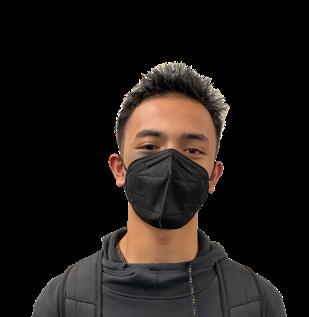
Aside from meeting with the administration, SPA also asked for feedback from faculty about the schedule. Many common complaints arose, so various schedule prototypes with more noticeable changes were proposed but ultimately turned down. They addressed the concern that students didn’t use tutorial effectively at the end of the day. It was suggested that tutorial would be moved to the morning, and then students would have time to do homework due for any
of the three classes later that day. “Kids having a guaranteed half hour in the morning that they could do work might actually alleviate some of the sleep problems kids have staying up late because they’re trying to
get everything done and they don’t have any time at school to get anything done,” Anderson said.
Passing time was also addressed, eliminating the pressure teachers feel to end class early for students to get to their
next class on time. These ten-minute breaks also allow students to take a breather between every 75-minute class. “There’s always something that breaks up the sitting and sitting in class,” Anderson said.
Republican primary voters face a quandary.
Former President Donald Trump faces four separate criminal proceedings, all while he attempts to run for re-election to the office in the 2024 election. The two federal and two state cases all carry felony charges and significant jail time. The ballot for voters in the 2024 election may, for the first time, include a presidential candidate indicted on multiple felony charges and, potentially, even a convicted felon.
So, does the 2024 presidential campaign path go through the courtroom? With their leading candidate’s viral mugshot trending on the internet and 91 separate felony charges across multiple jurisdictions,
Trump retains a massive lead in primary polls, with the indictments positively affecting his poll lead with GOP voters rallying around him.
“I think it’s very interesting how the effect on his campaign has only been positive,” sophomore Patrick Wall said.
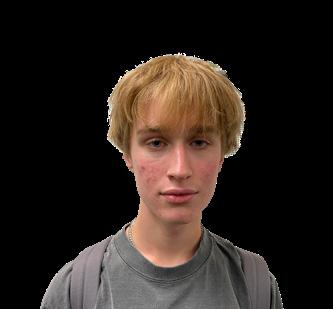
In the most recent of the cases, Trump was booked at Fulton County Jail on 13 felony charges of conspiring to overturn the 2020 election in the state of Georgia. These charges consist of falsifying documents, statements, writings, forgery, and impersonating a public offer around the time of the 2020 election.

If convicted, these 13 felony counts carry up to 50 years of jail time. The Georgia trial is not currently scheduled.
The first federal charges against Trump relate to his mishandling of classified national security materials in his home at the Mar-a-Lago Club in Florida. The 40 felony counts include various charges connected to endangering the country’s national security. An FBI search of Mar-a-Lago uncovered top-secret documents in an unsecured ballroom, a store room, and a bathroom. The Florida trial is scheduled to begin May 20, 2024.
The second federal charge stems from Trump’s actions to try to reverse the outcome of the 2020 election in The District of Columbia. Trump has four felony counts: a charge of conspiracy to defraud the United States, conspiracy to obstruct an official proceeding, obstruction of an attempt to obstruct an official proceeding, and conspiracy against rights. It is currently scheduled to start March 4, 2024, in the District of Columbia. It is set to be the first of the Trump felony cases to hit the courtroom.
Lastly, the state case in New York charges consists of 34 felony charges associated with falsifying business records. These charges arise from hush money payments to an adult film star that Trump allegedly paid off to keep their relationship
quiet on the eve of the 2020 election.
New York prosecutors allege that these under-the-table payments were taken from campaign contributions that should have been disclosed. Each of these counts averages four years of jail time, with a trial scheduled to begin March 25, 2024.
“No one is above the law,” Patrick Wall said. “I think it just rallies his base even further.”
Whether Trump faces jail time or not will be decided by judges and jurors, but he will also face the electorate at the ballot box. Voters wanting to hear from Trump could go to Iowa or New Hampshire, but in 2024, defendant Trump’s campaign appears ready to swing through criminal courtrooms.
BY THE NUMBERSfelony counts in NY 34
felony counts in FL 40
4
felony counts in Washington, D.C.
felony counts in GA 13
I THINK IT JUST RALLIES HIS BASE EVEN FURTHER.
“
sophomore Patrick Wall
I don’t like how [the schedule] is playing out on Wednesday since I have ... back to back
Turned alumni/ae after they walked across the North Lawn stage in June, the Class of 2023 has mostly embarked on one of life’s biggest adventures: leaving home for college.
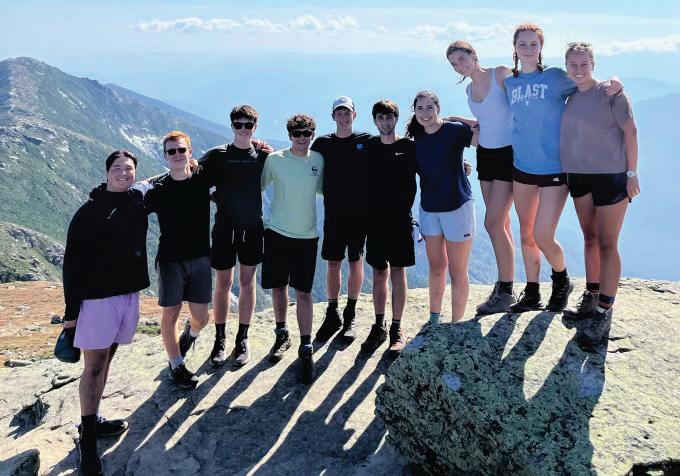
Hannah Brass chose Purdue University, and she’s studying engineering. “I wanted to go out of state so I could experience somewhere new,” Brass said.
She started the year with a hefty 18 credits, balancing her academic life with new social and extracurricular adventures. Brass joined rugby, choir, and medieval society.
Even with such a full plate, she has found time for making new friends. It’s a combination of “going to clubs” and simply “wandering around the campus and talking to people,” she said.
Brass notes that socializing in the college environment has proved manageable.
“There’s so much to do and a lot of cool people, even for people like me who sometimes have a hard time meeting people,” she said.
Over at Dartmouth College, Maddy Fisher chose a path, then changed it. Initially considering a school in Scotland, she opted for Dartmouth because of its strong academics.
“I didn’t think I was ready to go to a school that was a 13-hour travel day away,” Fisher said.
Her first weeks have been different than most, as Dartmouth’s freshmen travel to kick off the year.
“I did the most strenuous hiking trip; it was super chaotic and incredibly difficult but really fun,” Fisher said. “I like that the school does it because you get close to people you might not be in classes with.”
Now, Fisher is gearing up to join womens club soccer and using games as a place to meet friends. To build connections, she started a pickup soccer group chat.
Six hours south of Dartmouth near Philadelphia, Tenzin Bawa navigates his first few weeks of classes at Swarthmore College. Bawa enters as an undecided major but is leaning toward engineering and economics.

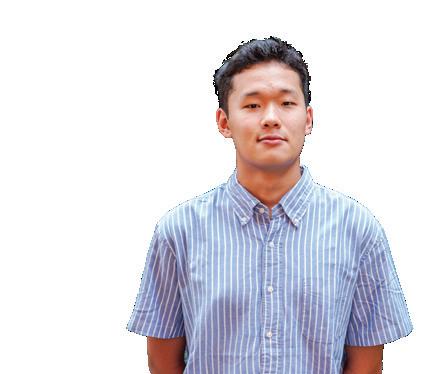
“I wanted to attend college further from home so I could have some more space to grow independently,” he explained. “I definitely love and miss my parents and Minnesota, but I wanted to put myself in a new environment.”
He’s already been making friends with people in his
dorm and classes. He predicts that “things will heat up pretty soon.”
The most memorable moment from his early weeks in college was leaving. “Ironically, one of my highlights so far wasn’t on campus, but in Philadelphia. We got on the train to the city and saw the sights, ate good food, and sweltered under the heat wave,” he said.
Although Bawa’s classes may intensify soon, he feels well-prepared for them.
According to the profile published by College Counseling, the 98 members of the Class of 2023 applied to 190 colleges and enrolled at 64 campuses.
When students sit down in the auditorium for senior speeches on Thursday X-Period, they’ll notice some big differences that don’t just include the timing in the schedule.
Administration implemented a variety of changes to speeches with some input from Upper School Council.
The most visible are that speeches are in the afternoon instead of the morning, and the time slot (and each individual speech) is slightly shorter. USC quotes and fun facts for each speaker have been cut—and all speaker introductions are at the beginning of the assembly instead between each speech. Intros are limited to 30 seconds each.
USC co-president Henry Choi noted that due to this year’s new school schedule, which shortened X-period (the time slot during which senior speeches take place), either intros or USC-presented quotes and fun
facts needed to be cut.
“Given the choice between the chosen superlatives and quotes, [USC] chose [to keep] intros. We feel like it’s a lot more personal, and people get a lot more enjoyment out of those,” Choi said.
deliver speeches each week and in what order.
The goal of the cohort is to make the senior speech process less isolating, since the process takes place outside of any designated class.
Ideally, cohorts will help speakers workshop their ideas while writing and give them an opportunity to share their speeches with classmates before their speech date.
Senior speech advisor Andrew Inchiosa noted that the cohort system was not created due to any new schedule changes, but because of its potential positive impact on the speech experience.
A behind-the-scenes change was also implemented: instead of being assigned a specific speaking date, senior speakers are assigned a cohort. This group is made up of eight seniors who will present their speeches in a two-week span; four will go one week and four another. The cohort decides which members
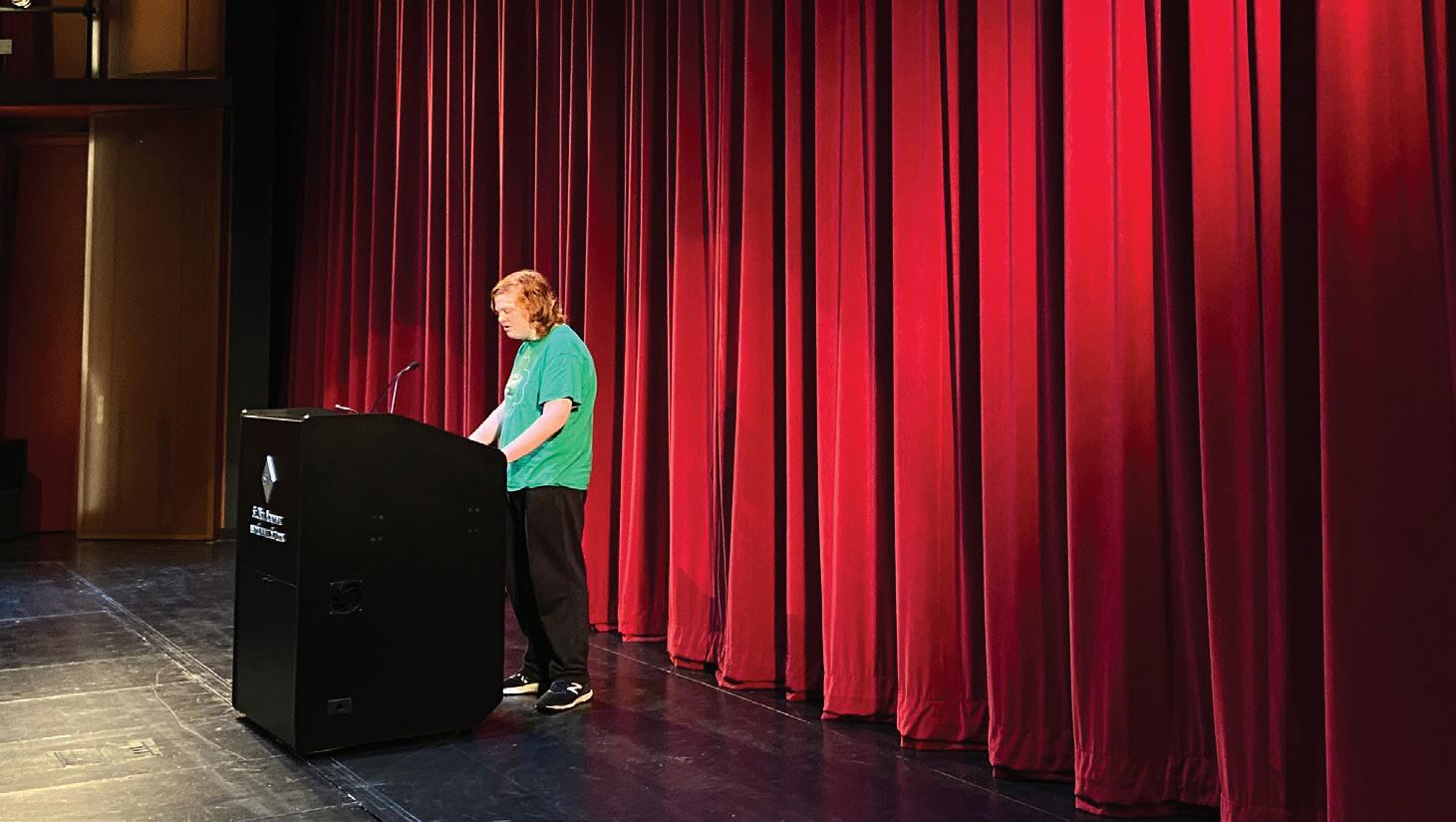
“Cohorts, in a way, [are] a way to create a little more structure, where… there’s several moments of connection with people who are going to give their speeches around the same time as you are,” Inchiosa said.
However, as a first week speaker, senior Anja Seifert felt fairly disconnected from her cohort.
Since she switched into the cohort for the
first week of speeches from a group scheduled for later, she missed the initial scheduling meeting, and after that, there weren’t any other formal meet-ups.
In the days leading up to her speech, Seifert had not talked to the other cohort members.
“I like talking to people about my speech; I like getting their opinions, but I did that with my friends. I forgot about
[the cohort system],” Seifert said.
“I feel like it’s invasive to go to my cohort,” she added, “because they’re also under pressure writing their own speeches.”
Senior speeches for the class of 2024 began Sept. 21. Future speech dates for the first semester can be found on the X-period schedule document in the US Students Google Classroom. For attendees outside the campus, up -
coming speakers are posted in the Friday newsletter sent to families.
Want to know how the first day of speeches went? Read the story at RubicOnline
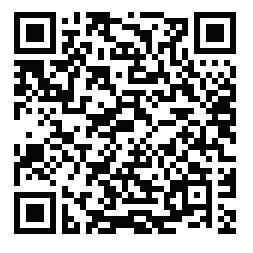
I DEFINITELY LOVE AND MISS MY PARENTS AND MINNESOTA, BUT I WANTED TO PUT MYSELF IN A NEW ENVIRONMENT.
Tenzin Bawa ‘23
WE FEEL LIKE [INTROS ARE] A LOT MORE PERSONAL, AND PEOPLE GET A LOT MORE ENJOYMENT OUT OF THOSE.
“
senior Henry Choi
OUR MISSION
We strive to capture the spirit of the community through its stories while inspiring deeper conversations. Above all, we stand for integrity in our pursuit to inform and engage our readers.
THE RUBICON
St. Paul Academy and Summit School
1712 Randolph Ave • St. Paul, MN 55105
rubicon.spa@gmail.com
www.rubiconline.com
@TheRubiconSPA
CO-EDITOR-IN-CHIEF
CHIEF VISUAL EDITOR
NEWS EDITORS
OPINIONS EDITOR IN DEPTH EDITOR
FEATURE EDITORS
SPORTS EDITORS A&E EDITORS COPY EDITOR
Claire Kim
Orion Kim
Georgia Ross
Grace Medrano
Sonia Kharbanda
Eliza Farley
Johanna Pierach
Annie Zhang
Amanda Hsu
Clara Ann Bagnoli
Juan Miguel Adams
McKinley Garner
Peter Ostrem
Olympia Wolff
Annika Kim
DIRECTOR OF RUBICONLINE
PRODUCTION MANAGER
CREATIVE DESIGN MANAGER
SOCIAL MEDIA MANAGER NEWS EDITORS
Clara McKoy
Eliana Mann
Rita Li
Mariam Malik
Lani Ngonethong
Greyson Sale
Siri Pattison
Lucy Thomas
Zadie Martin
Zimo Xie
Andrew Lipinsky
Nora McKoy
Thomas Chen
Davan Rosen
Aarushi Bahadur
Thomas Kovarik
STAFF WRITERS
Lina Abid, Jack Bettenburg, Eric Bjorgvinsson, Aldegundo Brenneman, Ivy Evans, Millie Farrington, Wynter Feiner, Nora Grande, Peter Lipinsky, Connor McSweeney, Allan Wang
ADVISER Kathryn Campbell, CJE
PUBLICATIONS ASSISTANT
Meghan Joyce
MEMBERSHIPS
Columbia Scholastic Press Association
National Scholastic Press Association
MN High School Press Association
Quill and Scroll Honor Society
PUBLICATION AWARDS
2023 NSPA All-American, 2023 Pacemaker Finalist 2023 CSPA Silver Crown Award Winner 2023 SNO Distinguished Site
When the upper school introduced its first affinity group, the was entirely new to us at the time, and the group faced criticism for being cliquey and excluding people who didn’t identify with a marginalized group. With time and awareness, the community now celebrates affinity groups and actively works to make them more inclusive for the identities they are working to create a space for.
An affinity group, by definition, unites individuals with a shared identity, whether that be racial, cultural, religious, or something else. Affinity groups work by creating a place for students with a shared identity to connect and find similarity in a place where it may be hard to find in other places in the community. A 2015 article in the publication Teaching Tolerance mentioned that affinity groups help marginalized student communities to better turn discussion into action, meaning that not only do they provide a safe space, but also help facilitate safety in non-affinity places. The Society for Human Resource Management also says that these groups help with increasing diversity, morale and even productivity.
In the past few years, starting a new affinity group has been normalized and made easy to do, which helps facilitate a community that is introspective on how they act regarding diversity, equity and inclusion. This helps foster a sense of belonging for students who may be underrepresented in school, as it allows them to have groups of people with a shared identity to bond with.
And who doesn’t like spending time with people who get them without a need to explain or provide context for real experiences connected to identity?
Central to affinity groups is creating space for students to relax and not have to think about their identity as much, to be heard and understood by the people who share their identity. Students are given the option to have a fun time with people who share an affinity with them, and not have to bear the stress of having to find solutions to the everyday problems they may face, which can include microaggressions and isolation.
Recent schedule changes have allotted specific time for affinity groups, relieving the FOMO that may come from a student who wants to participate in an affinity group but doesn’t want to give up Tutorial for meeting with teachers or a sport after school. However, while administration has done a good job creating designated time affinity groups this year, students who identify with multiple groups still have to pick and choose, and affinity groups only meet once every other week.
Still, there may be a solution.
For students with intersectional identities, it will be important to mix it up when it comes to which group to attend. For students who have avoided affinity groups, thinking that they are extra work, know that their main purpose is to help people feel more comfortable with their identity, not necessarily to address every issue they face.
For students who don’t identify with any of the current affinity groups, consider proposing a new affinity group tailored a unique identity. Create a space to make new connections.

of the staff agree 100% EDITORIAL THE RUBICON STAFF
NOT ONLY DO [AFFINITY GROUPS] PROVIDE A SAFE SPACE, BUT THEY ALSO HELP FACILITATE SAFETY IN NONAFFINITY PLACES.
The collaboration between C3, administration, and operations may not be something students thought they needed. Still, a desire to spread awareness of community safety and thinking about what to do in case emergencies happen is a noble effort. Students should take this opportunity to lean into the discussion and take it seriously.
Each week of Community Partnership Month will have a different safety focus. The goal of the focus weeks is to raise awareness community about different safety risks so that students are more prepared for them in the case they do occur. Students should engage within the month during planned discussions with their advisories or practice drills in order to truly be prepared in case their safety is threatened.
Outside of mandated safety drills by the state of Minnesota, the community has not brought much awareness to an ever growing problem such as school shootings in the past. According to
ILLUSTRATION: Annika Kim
STAYING SAFE. Community Partnership Month aims to inform students about the many safety risks that exist at school. Since there have been student concerns about a lack of safety awareness, this month will be the perfect time to dial in and have those important conversations.
EducationWeek, in 2022, U.S. schools experienced 51 school shootings by the end of the year, injuring 100 people and killing 40.
Two of the 51 school shootings occurred in the Twin Cities.
As these numbers continue to grow, the threat
of a school shooter also increases. Currently, the number of lockdown drills is limited and discussion around the topic feels hushed.
It is vital that both students and teachers have thought of what they will do in worst case scenarios before they are in an
emergency moment.
In an article published by Child Mind Institute, Rachel Emhke and Jamie Howard, freelance writer and PhD respectively, wrote that “Talking to kids about school shootings is important. Kids actually feel less scared when they get to talk
about scary things.”
Engaging in planned community discussion during Community Partnership Month can prove to be beneficial in the case a closed campus or active threat scenario does happen.
Additionally, although Minnesota has 47% fewer
school fires than the national average according to the Minnesota Department of Public Safety, the state of Minnesota requires all schools to proceed with five fire drills throughout the year.
While low fire numbers and frequent drills may seem like a good thing, students treat these drills as a mere disturbance in their school day, not acknowledging the importance of these mandated drills. The efforts of Community Partnership Month opened by covering details about fire safety and explained to students why their day is being disrupted.
Community Partnership Month will provide insight and educate students on how to navigate dangerous situations.
Students should be attentive and actively engage throughout the month during each focus week.
Something as simple as sharing an idea or telling a classmate not to goof off makes a world of a difference in staying safe at school.
READ MORE IN NEWS, PAGE 2
Affirmative action: What pops into mind at that phrase? With the Supreme Court ruling to end it this summer, the question is whether or not campuses will prioritize diversity.
To properly answer that question, it’s important to understand affirmative action’s role in admissions. What purpose did it serve in education? Most simply, it was a plan to provide opportunity to all people, regardless of race or gender. The transparency of including identity data in applications allowed universities to take gender and race into account during the admissions process; it allowed schools to strive for a certain quota of gender and racial presence on campus, to produce more diverse leaders.
Affirmative action was, at its core, about creating opportunity where it didn’t exist historically.
Still, affirmative action primarily benefitted white women since its inception in 1953. Ever since it was
PUBLICATION INFO The Rubicon is a public forum for student expression. We distribute 400 copies of each issue to the upper school at no cost to student readers.
ADVERTISING The Rubicon does not accept advertisements.
ANONYMOUS SOURCES Although it is always preferable to use names when reporting, there are times when it is necessary to protect those we report on. In the case of a student, the use of grade level as a name designation will be the preferred method of anonymity.
put into place, the number of women in most colleges has slowly risen. While the perception was that spots in schools were being taken from white students and given to POC students, realistically the majority of change took place in gender equity.
According to Pew Research Center, 50% of adult Americans interviewed disapproved of affirmative action, with 52% of Asian people disapproving, 57% of white people disapproving, 39% of Hispanic people disagreeing, and 29% of Black people disagreeing. Many reported their views were tied to a misinformed bias that affirmative action was taking spots away from qualified students to give them to underqualified Black and Hispanic students.
Affirmative action was a necessary facet of society to keep diversity levels up. The real problems stand with legacy admissions—those students are the underqualified people taking spots away from those who would bring something new to campuses. Giving spots to students of color and different genders is not the problem; reserving spots for students simply be-
BY LINES credit the individual who conducted interviews, drafted, revised and fact-checked an assigned story. Shared bylines are given to joint effort assignments. Stories that include supplemental materials include a credit at the bottom that states “Additional reporting by” followed by the name of the reporter.
EDITORIALS articulate the collective opinion of The Rubicon staff, while mini-editorials, opinions pieces, arts reviews, and columns belong to the author.
SUBMISSION GUIDELINES

Opinions are welcomed as Letters to the Editor or Submitted Opinions and may be published in the print or edition. Letters to the Editor should not exceed 400 words and Submitted Opinions should not exceed 650 words. Both may be edited for length and style. All pieces must be submitted and will be published with a full name.
UPDATES AND CORRECTIONS
During the post-critique process, staff members identify inaccuracies and report feedback from readers. The staff publishes corrections when an error is
AFFIRMATIVE ACTION opinions by the numbers
49% of adults in the U.S. think that making admission decisions with regard to race and ethnicity makes the process less fair
36%
of adults in the U.S. think that considering race and ethnicity is good for ensuring equal opportunities
INFORMATION: Pew Research Center (2023)
cause of a large donation or generational connection is the problem.
Affirmative action was important, and its loss will have negative impacts on the diversities in our society.
In order to combat the negative impacts of overturning affirmative action, students must continue conversations about diversity, and not use their connections to influence the admissions process. Honesty and advocacy will provide the solutions.
READ MORE IN FEATURE, PAGE 7
discovered during critique or reported to a staff member. Corrections should be directed to the Editor in Chief or appropriate section editor.
IN PRINT: Corrections are printed at the bottom of News p. 2. Corrections will be printed in the month following the error and, if the story is also published online, will be corrected following the online corrections policy.
PHOTO CREDITS Photos taken by staff members are labeled with their respective staff. Images sourced from outside of the publications staff are
credited information pertaining to their origination.
NAME AND PRONOUN USE
The Rubicon uses the name and pronouns reported by the individual source. Each interview and survey begins with a request to say and spell the person’s name and to share the pronouns they would like to see published in the story, and the reporter is transparent about where the story will be published. If a mistake is made in the course of reporting, a correction will be posted per the corrections policy.
FIVE FREEDOMS. The First Amendment of the Constitution lays out five essential freedoms for American citizens. Over the summer, co-Editor in Chief Orion Kim dove deep into the nuances of the Amendment. “Reporters might be able to cover content freely, but that doesn’t mean they shouldn’t respect the people they’re covering,” Kim wrote.
ILLUSTRATION: Orion Kim

This past summer from Jun. 24-29, I had the honor of representing Minnesota at the Al Neuharth Free Spirit and Journalism Conference. The program selects one rising senior from each state and Washington, D.C. with the hope of informing young journalists about First Amendment freedoms and preparing them for careers in journalism.
After a week of riveting panel discussions, tours of C-SPAN and the Wall Street Journal bureau, conversations with Pulitzer-Prize-winning journalists, and late-night sightseeing, I wanted to take the time to reflect on what I learned about the First Amendment.
Throughout the entire week, lessons about the First Amendment were structured into our schedule, but the basis of our knowledge was taught during the first panel. In this session, First Amendment specialist at the Freedom Forum Kevin Goldberg led a discussion primarily focused on common misconceptions of the amendment’s freedoms.
Goldberg commenced the presentation by reading aloud the amendment as it appears in the Bill of Rights: “Congress shall make no law respecting an establishment of religion, or prohibiting the free exercise thereof, or abridging the freedom of speech, or of the press; or the right of the people peaceably to assemble, and to petition the Government for a redress of grievances.”
He then laid out the five freedoms: religion, speech, press, assembly, and petition. These freedoms are protected under all three branches of the government on the local, state, and federal levels. However, the protection granted under these rights is only reserved under the government. One of the most frequent misconceptions is that First Amendment rights are applicable to private institutions, which is simply not true.
Another topic that Goldberg brought up is that the government can’t compel speech any more than it can restrict it. For example, in Wooley V. Maynard, the U.S. Supreme Court ruled that New Hampshire could not force residents to sport license plates that opposed their moral values.
While the majority of speech is protected by the government, there are some exceptions. This includes but is not limited to defamation, obscenity, blackmail, perjury, plagiarism, and solicitation to commit crimes.
The First Amendment is far from perfect. There are countless caveats and exceptions that make misconceptions habitual. At the end of the presentation, Goldberg made one final remark: it’s incredibly important to know the specificities of the First Amendment, but that knowledge shouldn’t serve as moral guidance.
The restructuring of the daily schedule has been a complete disaster. For one, those giving senior speeches and those who will be listening have unilaterally complained about the restructuring of the speech structure. For context, the administration is shortening the amount of time for students to give their speeches and is imposing similar, more serious restrictions on senior speech introductions. What the administration is doing here is telling students that their speeches—which many spend months or years contemplating—are less important than five, awkwardly-timed minutes of passing time. Speech introductions, quotes, superlatives, and the like are a school tradition. Such traditions will impact students’ experiences in a far greater capacity than five or ten minutes of passing time between periods.
Advisory communities are intended as spaces for students who may not otherwise connect to socialize. The administration’s passing time inclusion directly removes from the length of the Wednesday advisory period, and moving the advisory / X-period time to the afternoon also eliminates the tradition of advisory snacks. In theory, built-in passing time will allow for classes to start on time on a more reliable basis. However, the opportunity to save one or two minutes of class time does not appear to be worth the elimination of school traditions.
If the administration insists on adding five minutes of passing time between block 2 and the early period 3/7, then we should transition back to the schedule of past years and either push back period 3/7 and eliminate 5 minutes from tutorial, which was utilized less effectively than x-period and advisory, or they should eliminate 5 minutes from the morning 10-minute advisory time which, as it is now, isn’t enough time to be spent in a meaningful way beyond a few brief announcements.
Speech is often framed as the most celebrated of the five freedoms, so it serves as the best example. Just because certain speech is permitted under the law does not mean it should be said. As Goldberg emphasized in his presentation, the U.S. ultimately decided to protect all speech and not restrict it. It’s better to have all speech with some detrimental speech, than no speech at all. It’s up to the citizens themselves to monitor remarks that may be harmful.

One example of detrimental speech that is generally protected by the First Amendment is hate speech. However, that doesn’t mean hate speech is morally justifiable under any circumstance. On a less extreme level, this reasoning is applicable to all five freedoms. Pertaining to journalism, reporters might be able to cover content freely, but that doesn’t mean they shouldn’t respect the people they’re covering.
By the end of the journalism conference, this message was clear: The First Amendment is one of the most significant pieces of the Constitution that grants many freedoms fundamental to all citizens. However, it is up to the citizens themselves to understand the amendment, and not abuse it.
Will Richardson Class of 2024The Rubicon aims to publish letters to the editor written by students about issues and topics you care about. A range of topics are acceptable, but letters in response to our content are prioritized. Letters should not exceed 400 words.
read more letters in OPINIONS and submit your own through the form at:
RUBICON online

THE
RUBICONWith recent news of a potential meeting between North Korean leader Kim Jong-un and the Kremlin to discuss an arms deal, it seems that the year-long con-
flict between Russia and Ukraine will not end anytime soon. This might come as a shock to some Americans, since Ukraine has been seemingly in the background of news and social media feeds for some time now. If this deal goes through, it will mean countless lives are at stake. Instead of treating this news as another headline, take this opportunity to engage with and care about our allies overseas.
It might be hard for
senior Clara Ann Bagnoli
casual news readers and social media users to care about something that seems abstract and far away. However, daily
life is, and will be, affected by Russia’s actions in Ukraine.

Russia is one of the world’s leading oil producers. While only 8% of that comes directly to the U.S., less oil in the EU leads to a delay in trade. Trade delays continue throught the system, creatings clog and creating less competition, which in turn increases oil prices everywhere. With a second winter at war approaching, accessibility to oil is especially
important as houses need to be heated.
But it is not just Russian exports that we need to pay attention to. Ukraine is known as the breadbasket of the world, with over 70% of the country being used as farmland producing sunflowers, corn and wheat.
Food prices around Europe are going up as supply is going down, and people are going hungry.
Most importantly, it is important in general to keep up to date because
the news affects someone else. Through the federal program Uniting for Ukraine, almost a thousand Ukrainian refugees have been relocated to Minnesota since the invasion in early 2022. People have lost their jobs, homes, and families.
It is the least we can do to stay informed and remember there is a world outside of our own. Continue to read articles, watch the news and listen to overall coverage of the affair.
TAKE THIS OPPORTUNITY TO ENGAGE WITH AND CARE ABOUT OUR ALLIES OVERSEAS.
IT’S UP TO THE CITIZENS THEMSELVES TO MONITOR REMARKS THAT MAY BE HARMFUL.senior Orion Kim FLAG: Wikimedia Commons
Community time worth more than passing time
From wildfires in Hawaii and Hurricane Idalia in Florida, to a summer of poor air quality in Canada, natural disasters are ravaging the globe.
“Almost every day, we look on the news and see drastic weather effects,” senior Violet Benson said.
THE SCIENCE AGREES
The World Meteorological Organization stated in a 2021 report that over a 50-year period between 1970 and 2019, on average, a natural disaster occurred daily. Furthermore, about 115 people were killed and $202 million USD was lost in damages to natural disasters daily. They also found that the number of disasters in the last ten years of the study was five times the number of disasters in the first ten.
According to the US Geological Survey (USGS), climate change is the reason behind this increase.
The 2022 Global Climate Report by the National Centers for Environmental Information (NCEI) found that “the last nine years [rank] as the nine warmest years on record.”
With rising surface and air temperatures, “[Any disaster] that’s affected by air temperature or water temperature is going to be increased,”
Environmental Science teacher Rachel Yost-Dubrow said.
More water vapor is evaporating, creating more intense storms, and higher temperatures exacerbate wind speeds in tropical storms.
“We’re seeing more hurricanes this season than we ever have. That’s because ocean temperatures in the Atlantic are warmer than they’ve ever been,” Yost-Dubrow explained.
mate change will include a decrease in sea ice and an increase in permafrost thawing, [and] an increase in heat waves and heavy precipitation.”
Changes will vary by region and climate, but it is clear that precipitation, heat waves, and erosion are expected to worsen.
As natural disasters have increased, so too have financial damages.
The World Meteorological Organization found that just as the number of disasters increased fivefold from the first to the last ten years of the study, economic losses in the last ten years were seven times the losses in the first ten.
generational wealth and resources to recover from worsening disasters.
Amidst all the disheartening news, there is some success. The World Meteorological Organization reported that the number of deaths in each disaster has decreased over the 50-year period due to improved disaster warnings and better aid.
Still, as the impacts of climate change are increasingly felt, natural disasters are only intensifying.
“If you look at each weather event individually, you can’t claim that [it was caused by climate change] but if you look at the repeated pattern of increased severity in hurricanes or the repeated pattern of increased severity and number of forest fires, then you can attribute that to climate change,” senior Carys Hardy said.


USGS reports that “long-term effects of cli-

The impact is also not felt equally: disasters disproportionately affect lower-income countries. According to the United Nations, 91% of deaths from natural disasters took place in “developing economies.”
In the United States, Black families and people of color have been historically redlined into less desirable neighborhoods. These areas were “more prone to flooding and tropical storms,” according to a 2021 report by the Coastal Resilience Center at UNC-Chapel Hill.
In turn, Black communities were left without
“I’m really privileged to be in an area that isn’t necessarily directly affected, like my health hasn’t ever been put at risk or my safety. But that’s definitely not the case for everyone,” Benson said. She added that, “It’s really important to recognize the privilege we have to be in an area that doesn’t take the brunt of all of the world’s collective downfall on taking care of the environment.”
Climate activists say “1.5 degrees Celsius to stay alive,” but the policies in place right now will lead to more than a 2.8 degrees Celsius raise in global temperatures before the end of the century, according to the United Nations.
What is SPA doing to secure a sustainable future? Where do students fit into this discussion?
Out of seven students surveyed who were asked how much they cared about SPA’s commitment
to sustainability on a scale from zero to 10, the average answer was eight. But many students struggled
to answer the question of what they thought the school was doing well.
“I don’t really know a lot of SPA’s practices towards sustainability,” junior Saurin Patel said. This statement was true for multiple students.

Most interviewees cited the school’s compost system as a positive effort toward sustainability, although Patel did not mention it.
Senior Nadia Degnan believed that the compost bins were a step in the right direction, but said that “sharing infor-
mation with the students and [being transparent]” would be helpful for the school in communicating sustainability efforts. Similar to other students, Degnan was unclear on how SPA has made sustainability efforts.
As far as how the Randolph Campus can become more sustainable, Degnan believes that the school could improve its schedule around turning on the AC, because there is no need to have it be “uncomfortable” during the more well-tempered months.
Senior Clare Kimmel cares deeply about the environment. As a student in the Environmental Science elective, she believes that institutional changes have the potential to make a significant impact.

Kimmel mentioned how it is “important for large institutions like schools to be sustainable, because they produce a lot of waste and require a lot of energy.”
In fact, the U.S. Department of Energy reported that schools emit an estimated 72 million metric
tons of carbon dioxide.
To offset those emissions would require 85,861,273 acres of U.S. forests, which is 35% of the country’s land.
Kimmel said that it is important for schools to do their part by “modeling sustainability to young people, [because] in places like school, kids will learn sustainable practices that they can implement at home … or after high school.”
ALMOST EVERYDAY, WE LOOK ON THE NEWS AND SEE DRASTIC WEATHER EFFECTS.
senior Violet Benson
I DON’T REALLY KNOW A LOT OF SPA’S PRACTICES TOWARDS SUSTAINABILITY.
junior Saurin Patel
“

Conditions that favor storm growth are expected to increase across North America, causing tornadoes to become more frequent in unusual seasons. And there is already a trend. According to John T. Allen, a professor of meteorology at Central Michigan University, there has been an increase in tornado outbreaks over the past few decades.
Hotter temperatures and drier climates due to climate change are more flammable, thus leading to a longer and more active fire season. A 2016 study found that climate change intensified the amount of dry organic matter and doubled the amount of severe fires between 1984 and 2015 in the western United States.
Likewise with tornadoes, warmer temperatures induced by climate change has affected hurricane activity. The most damaging hurricanes are three times more common than a century ago. Furthermore, the proportion of hurricanes in the Atlantic that are Category 3 or above has doubled since 1980.
ILLUSTRATION: Annika Kim
INFOGRAPHIC: Johanna Pierach, Orion Kim

With the rise of environmental threats, existing and new clubs are looking for various ways to address environmental justice.
Currently, the Randolph Campus is home to 55 clubs, 12 of which are dedicated to the cause of student activism. Among these, Community Action and Service Club (CAS) is a prominent group looking to create change. Seniors Audrey Senaratna and Clara McKoy are the current presidents.
“We want to do more things that are involving student activism and engaging in the community rather than passive forms of service,” Senaratna said.
Last year, CAS took more internally focused efforts, such as hosting a car wash run by members of the club.
However, the group is in the process of expanding its scope of services, aiming to incorporate a broader approach.
“I think it’d be really interesting to include more environmental justice into what we do,” Senaratna added.

Furthermore, the group has a substantial network of contact for partnerships with organizations. These connections span from local non-profits to community outreach initiatives affiliated with universities.
CAS member Via Campbell has hopes for the club’s future plans.
“I hope that we can schedule a clean up at Bridal Veil Falls, because there was a lot of trash there,” she said.
jectives surround fundraising efforts to support maritime foundations such as Save the Whales, an organization dedicated to preserving and protecting the ocean and its inhabitants.
The club’s mission encompasses multiple objectives. “We aim to change the perceptions of marine life, shifting it from being seen merely as a source of entertainment to recognizing these creatures as living beings,” Cook said.
“
freshman Via Campbell
Another proactive club making strides is led by freshman January Cook. This group, known as the Marine Biology Conservation Club, has a number of plans for the year ahead. Their ob -
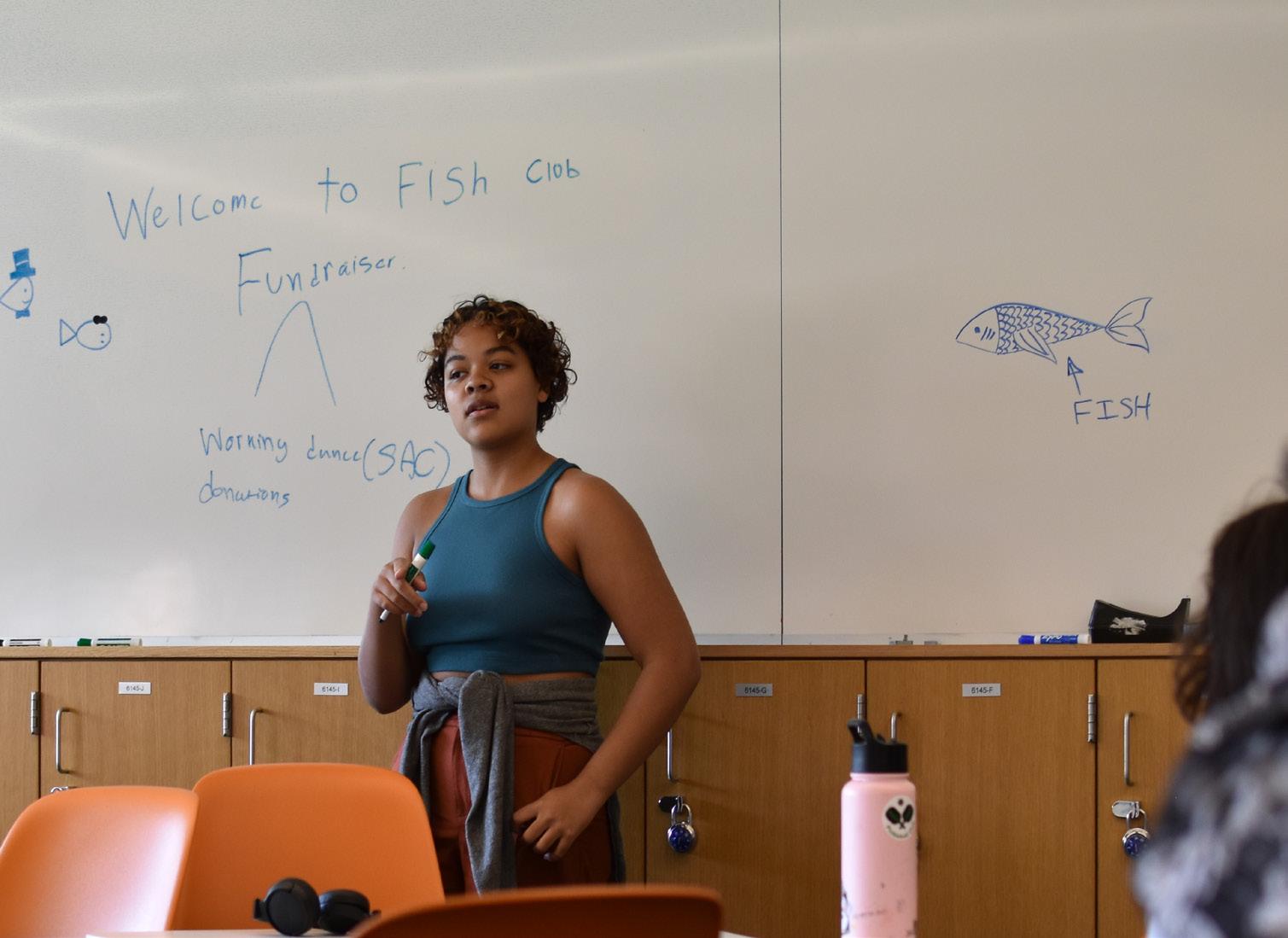
Additionally, the group seeks to scrutinize the unethical treatment of animals in establishments like Pet Smart and local aquariums.
“We are preparing to conduct a letter-writing campaign targeting prominent for-profit aquariums in Minnesota,” Cook said.
“We hope to educate individuals about small yet impactful changes they can make in their daily lives to promote sustainability within the local marine ecosystem.” The next club meetings are on Tuesday, Oct. 10, during X-period.
“...I know she’s always wanted me to go,” Gjerde said.
Similarly, senior Melina Kannankutty’s family was supportive of her decision to host an exchange student. Although Kannankutty will not be able to travel to Spain in June due to its proximity to graduation, she is happy to be able to take part in the program.

“I think my family was just really excited to be a part of [the exchange],” she said.
For junior Isidor Valdez, the chance to make a connection across countries was a major plus.
“The Spanish exchange is a great way to continue learning a new language while getting to know someone,” he said.
At the beginning of the program, participants received a digital letter from their exchange student, detailing fun facts as a personal introduction.
This fall, an exciting program has brought new additions to campus all the way from Spain. As part of the newly revitalized program, the Upper School welcomed a group of Spanish exchange students Sept. 14, from Colegio Malvar in Madrid who are staying in Minnesota with host families for two weeks. During this time, a multitude of events have been planned for the exchange students experience life in the U.S.
Junior Adele Gjerde signed up to host an exchange student through her Spanish class. She first heard about the program when US Spanish teacher Rolando Castellanos came and spoke with her class last spring. Gjerde decided to join the program after talking with her mom, who lived in the area of Spain where Colegio Malvar is located, the school she will eventually attend as an exchange student through this same program.
Outside of their letters, some students have been able to communicate via school email or social media platforms, however, not everyone has been so lucky.
In Minnesota, the exchange students will attend classes for two days, with the rest of the time embarking on outings and participating in activities set up by the school.

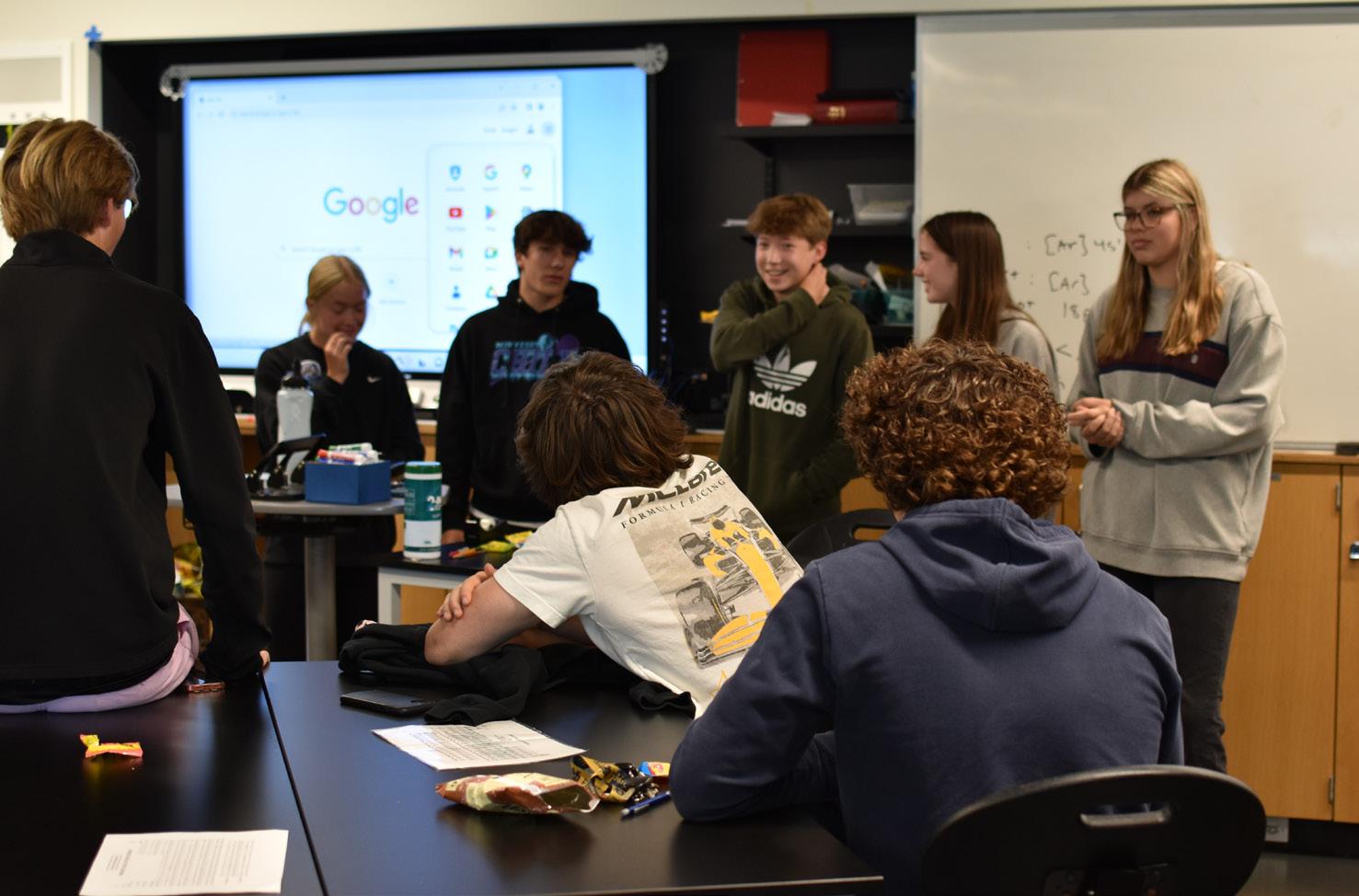
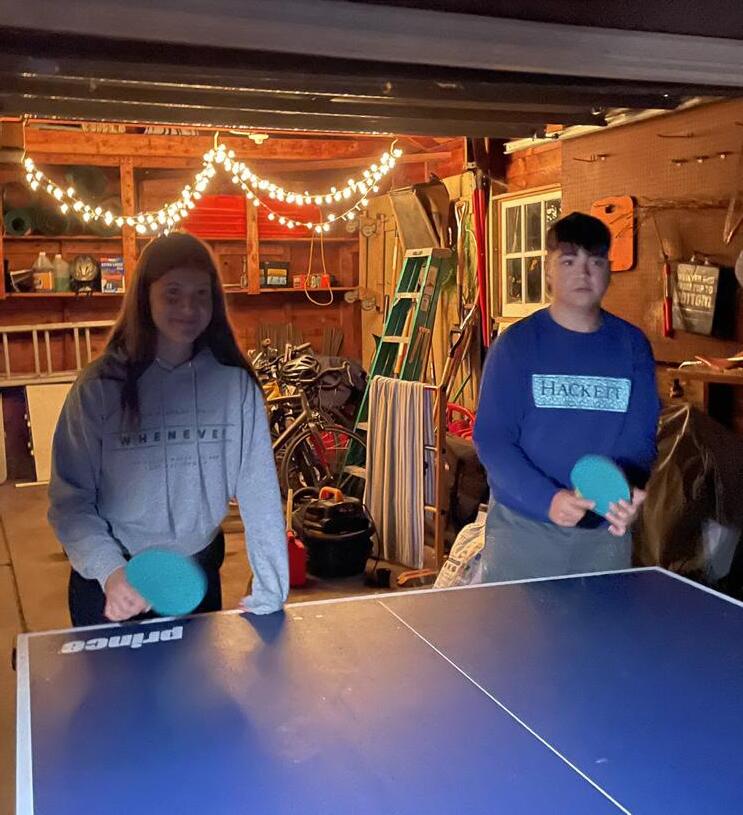

“They take [the exchange students] to multiple malls, the zoo, all of these things,” Kannankutty said. Host families will also have the opportunity to choose some of their own activities, especially on weekends.
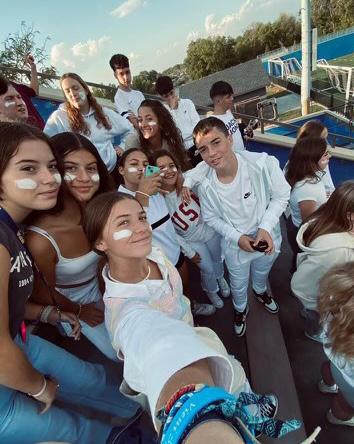
Anticipating the second part of the exchange, students will say goodbye to their exchange partners until June, when after graduation they will attend their host school during finals week. Due to COVID, the exchange program has been on hiatus, but has been partially revived this year with the hopes of forming new cross-cultural connections.
Every year, SPA gives the opportunity to create spaces to express their individual or interests or identities through affinity groups or clubs. These groups are advertised during early September
TTRPG is co-led by Sophomores Jack Hickman and Louis Fratzke. The club is focused on introducing new players and bringing in old players to play games such as Dungeons and Dragons (D&D) and Pathfinder as a community. “I just
new club, the sophomores had to undergo an extensive process of recruiting enough students and faculty advisor, along with finding a space for the club. TTRPG plans on meeting every Tuesday after school in RedLeaf Commons.
at the annual club fair. This year, a number of new clubs were featured at the club fair, including the South Asian Student Alliance (SASA) affinity group, the Marine Conservation club (MCC), the American Sign Language (ASL) club, the Model UN, and the Tabletop Role Playing Games (TTRPG) club.
wanted to create a space for people to play D&D,” Hickman said. “My plan is to get a list of people and split them into smaller groups. I’m looking for some people who have experience running games, and I’m going to talk new players through the process of creating their first character.”
In order to create a
SASA strives to create a safe space for people of South Asian descent. SASA is co-led by Seniors Anisa Deo, Audrey Senaratna, and Wafa Naqvi. Deo was a part of the Asian Student Alliance (ASA) last year but wanted to create something more curated for South Asian students.
“We need something for South Asian students as well. Both the leaders of ASA are East Asian, and they’re great but it’s obviously hard for them to cater more to South Asian. So that’s why we created SASA. We’re just gonna talk about how it feels to be a South Asian student
at SPA. And also just have fun. I feel like that’s important,” she said.
SPA’s newly established clubs are fostering a strong sense of community among their members with shared interests and experiences. From
role playing games, to affinity groups, SPA has a place for everyone to discover new interests and partake in embracing identity.
SASA meets in room 5215 during Friday tutorial, TTRPG meets
Tuesday after school in RedLeaf commons, MCC meets in room 6145, ASL club meets in room 6135 and Model UN meets in room 4220. MCC, ASL, and Model UN all meet during scheduled club time.
...[IT’S] A GREAT WAY TO CONTINUE LEARNING A NEW LANGUAGE WHILE GETTING TO KNOW SOMEONE.
junior Isidor Valdez
WE’RE JUST GONNA TALK ABOUT HOW IT FEELS TO BE A SOUTH ASIAN STUDENT AT SPA.
PURSUING PASSION. Although their projects are set to take weeks to months, the students feel that they will not lose interest due to their passion.
High school is treated as the time to experiment with new interests and within the US, a number of opportunities arise every year in which students are able to participate in. From Advanced Science Research to Advanced Technology Projects to the arts, students are offered the freedom to explore their interests on a large scale.
Junior Milan Mishra is working on a method for algae bloom monitoring using drones and machine learning. As a part of the Advanced Technology Projects class, his detector aims to automate the detection process by using the drone to take photos and analyze the images.

Mishra plans to finish within the next month or two to be able to present his final product at the Twin Cities Regional Science Fair later this school year.
“I became interested in the class as I’ve always
seen people working on cool projects in past years, and I knew I wanted to have some sort of longterm project,” he said.
Junior Adam Ebert has also been working on a device with real-life implementations: a robot that can locate a person or area while avoiding obstacles.

triangulation method or the way it locates objects, which is crucial to how the robot will work.
“It’s kind of just one of those issues where you first have to understand the math, you first have to do the math on paper, algebraically, and then you have to implement that into code. And if you didn’t know, computers don’t play nice with algebra,” he said.
In the future, Putaski wants to major in music for college. She views the one-act version of “Still Here” as a stepping stone to creating larger musical works.
Meanwhile, Ebert’s FollowBot project is a way for him to learn new skills.
He plans for the robot, named FollowBot, to be used in the medical field and assist the elderly, as it can carry important objects and follow the user to a specific location. Having only started the project two weeks ago, Ebert expects the most challenging part to be the
Junior Ellie Putaski has been drafting a oneact titled “Still Here”, featuring several musical numbers that she hopes to direct. “Still Here” follows themes of nostalgia, growing up, and the fear of moving on as the main character meets her childhood best friend in her old hometown, who only she can see or remember.
“It’s been interesting doing research for styles of [instrumentals] and what I should include, as well as different characters. What key should it be in, time signature, stuff like that,” Putaski said.
“I’ve always been interested in electrical engineering and computer science, and so this kind of melds both really nicely,” he said.
Although the students work on different projects, they all have similar advice to give: start small, think it through, and take it one step at a time.
“Make sure that whatever you want to do is within your means, and that you like the topic enough so you won’t go crazy thinking about it for long periods of time,” Mishra said.
Although these projects are forecasted to take an extended amount of time, a highly anticipated end product will come as a result.
“I was really shocked when I heard the Supreme Court decision, because it really made me reconsider how I want to shape my application,” she said. “Would it be beneficial if I did it around my race? Or would it be better for me to conceal that and try to highlight other parts of my application?”
College Counselor Mary Hill described that as the new ruling changes what students can share in their applications; she believes diversity is still an important aspect that colleges consider.
“We want all students to really know and believe that as far as what is it that colleges value, … while this one piece, sort of like the checkbox of identity, can’t in and of itself be used, that the goal of still having a diverse learning community is still in place,” she said.
After the ban on affirmative action in Michigan in 2006, Black enrollments decreased from 8% of undergraduates in 2006 to the current 4%. However, many colleges have issued statements about their commitments to diversity regardless of the court’s decision. As Chief Justice John Roberts explained, universities can still consider an applicant’s discussion of how race has affected their life, leading to an increase in supplemental questions about identity.






ACTION IN ADMISSIONS. College
decision to eliminate affirmative action will affect the
ors will guide
through
CLAIRE KIM co-EDITOR IN CHIEF“The University values diversity, broadly defined to include diversity of experiences, perspectives, backgrounds, and talents.”
The University of Minnesota’s required question about diversity is just one of many added to college applications this year following the Supreme Court ruling in June, which banned the use of affirmative action in college admissions. Affirmative action is defined as the active effort to improve employment, educational, and other opportunities for discriminated groups; this can be on the grounds of race, disability, gender identity, sexual orientation, ethnicy, and age.
Additionally, the new ruling has led to increasing calls to end legacy admissions, in which a student has a greater chance of admission because of their relation to an alumnus. Often considered a form of affirmative action for wealthier students, many colleges have already taken steps to change their legacy admission policies.
For example, legacy admits fell from 11% to 6% in Amherst College’s incoming class after the college ended preferences for legacy students in October 2021.
As a junior, college choices haven’t been at the forefront of Deling Chen’s mind, but the new ruling prompted deeper thinking about activities she is involved in that might highlight her race.
Along with college counseling’s role in helping students represent themselves through their applications, senior Rishi Bhargava felt that discussion of national changes would also be helpful.
“If college counselors had a few sessions or if they’re willing to answer questions about how to write about your identity and essays effectively, I think that’d be helpful,” he said.
On the other hand, other students such as senior Declan Monahan feel that the ruling’s impact is minimal because colleges have already adjusted to the ruling accordingly with supplemental essays.
“...that’s the problem, [the ruling] doesn’t change anything because colleges are so on top of getting around it already,” he said.
While college counseling works to adjust to the new affirmative action ruling, the first college application deadlines for this year’s seniors will be impacted in November.

I’VE ALWAYS BEEN INTERESTED IN ELECTRICAL ENGINEERING.
junior Adam Ebert
“
ANNIKA KIM ILLUSTRATOR
CELEBRATING SUCCESS. Head of School Luis Ottley opens the second-annual ceremony in the Huss Auditorium with a few words. The induction of alumni to the Athletic Hall of Fame took place Sept. 8. The final inductee was Manuel Lagos, “A lot of us wouldn’t be here if it weren’t for Buzz,” Sanneh said.

THE RUBICON
Moving anecdotes. Personal stories. Awe-inducing accomplishments. Barbie references. All could be found at the second Athletics Hall of Fame Induction Ceremony on Sept. 8 in the Huss Auditorium. Out of 350 total nominations, 12 alumni and one long-time coach were honored with an induction.
Cross Country captain Taylor Barkwell volunteered at the ceremony, handing out programs and speaking to guests.
“I didn’t realize how many crazy good athletes we have had come from SPA,” Barkwell said. The ceremony began with a few words from Head of School Dr. Luis Ottley, who introduced emcees Jim McVeety and Kris Flom.
David Goins ‘64
Football, Wrestling, Track and Field
Goins made the monumental impact of being the first African-American student at St. Paul Academy, along with his brother who accepted the award on his behalf. He spoke about the novelty of having African-Americans at school when he and his brother were students, and how the lessons Goins learned at SPA helped him navigate complicated journeys throughout life.
William Langford ‘53
Football, Basketball, Baseball
Langford was a two year captain of Basketball and received all honors in Football. He ended his speech by emphasizing gratitude in the present.
Hilary Raudenbush Magnuson ‘59
Tennis, Field Hockey, Volleyball, Basketball
Magnuson’s love of sports carried her through college, where she competed on multiple varsity teams pre-Title IX. She eventually returned to SPA as a teacher in 1983, where her involvement in athletic activities significantly impacted the community. Magnuson retired in 2004.
Penelope Stout Shanks ‘58
Tennis, Field Hockey, Volleyball, Basketball, Softball
Penelope Stout Shanks (‘58), who competed in sports throughout her high school and college careers, later becoming a teacher and coach. Her brother accepted the award on her behalf.
Keren Gudeman ‘94 Soccer, Basketball, Track and Field
Keren Gudeman went on to make the lacrosse team at Harvard University despite never having played. Gudeman eventually returned to SPA as a teacher and coach. In between Barbie references and jokes, Gudeman shared how Flom and Magnuson were mentors for her during her time at SPA.
William Larson ‘79 Football, Wrestling, Track and Field
William Larson was involved in athletics at SPA and later at Harvard University, eventually playing one year of baseball in the Netherlands. The first SPA baseball player to have his jersey retired, Larson thanked his family, friends and teachers.
Elizabeth O’Brian ‘73 Tennis, Basketball
A member of one of the first graduating classes that merged St. Paul Academy and Summit School, O’Brien competed on the girls’ and boys’ varsity tennis teams, detailing in her speech what it was like to be a female athlete before Title IX.
Cathy Paper ‘85 Basketball, Tennis, Track and Field, Softball
While at SPA, Paper collected 14 varsity letters and captain honors five times, and helped bring her tennis team to three state championships. Paper reminisced on senior speeches, including the common use of acronyms, and used one to describe her time at SPA, crediting the people who helped her along the way.
Anthony Sanneh ‘90 Soccer, Basketball, Tennis
Playing on a soccer team that held a 63-game winning streak over two and a half seasons in the late eighties, Sanneh recognized the contributions of fellow inductee Manuel (“Buzz”) Lagos to his success.
“A lot of us wouldn’t be here if it weren’t for Buzz,” Sanneh said.
Sanneh went on to play soccer at the University of Wisconsin-Milwaukee and professionally on the United States Men’s National Soccer Team.
Going on the excel at hockey at the collegiate level while at Yale University. Sawkins received the Mallory
Award in 1985, recognizing Yale’s most outstanding senior male athlete, and went on to play hockey professionally for the Los Angeles Kings. Sawkins eventually returned to serve as SPA’s Athletics Director for four years starting in 2011.
Kira Gregersen Steiner ‘89 Tennis
The crowd was audibly impressed with Steiner’s accomplishments in tennis, including a record four years claiming the Class “A” State Singles Championship. Steiner’s tennis career continued into college at the University of Wisconsin, and eventually to a coaching position at the University of Illinois Chicago. Steiner’s brother accepted the award on her behalf.
Tom Vanelli ‘73 Football, Baseball, Hockey
A three-sport athlete who shined in hockey. The only hockey player to have his jersey retired by the SPA program, Vanelli served as captain of the topranked team in the state, setting the school record for most points, goals and assists.
He went on to play hockey for the University of Minnesota, winning two NCAA championships including one where he was named MVP of the tournament. Vanelli spoke of trying to make the best of his early days at SPA, back when the hockey arena had “chicken wire instead of plexiglass.” Vanelli credited his coach Mike Foley as his “major mentor and the one that convinced my parents that [SPA] would be a good place for me.” he said.
The final inductee, Manuel “Buzz” Lagos was welcomed with a standing ovation. Known as the “Father of Soccer” at SPA, Lagos began as the Head Coach of the boys’ soccer team in 1973, eventually leading the team to nine state appearances in the 1980s, four of which resulted in championship and two in runner-up titles. Additionally, Lagos founded and served as Head Coach for the Minnesota Thunder, the state’s longest running professional soccer team.
He also taught math in the upper school. Lagos’ introduction was filled with testimonies from those who knew him as a teacher, coach and influential human being in the lives of those he mentored. Now an assistant coach for boys soccer, he received a second standing ovation upon completion of his speech demonstrated Lagos’ continued influence in the school community.
THE RUBICON - SEPTEMBER
Injuries have taken many players off of courts and fields in recent years, with many athletes taking a break because of injuries. To help female athletes with injury prevention, the Powerhouse Gym and girls sports teams are partnering in a new screening and training program.
The focus on girls sports for the program is due to how female athletes are more likely to get injured, because of factors like estrogen, lower muscle mass and hormone differences. The most common injuries being ACL tears, plantar fasciitis, ankle sprains, and stress fractures.
Another reason for the focus being girls sports is
becuase according to Jill Lipsit, historically, girl’s sports have also been given fewer resources, such as strength training and nutrition coaching, compared to boy’s sports. This program is a step forward in helping girls sports with all these issues.

Junior Madelyn Moser participates year-round in volleyball, basketball and track. Having been
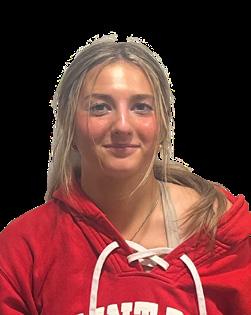

injured last year, Moser thinks many things can be improved regarding girls sports at SPA, including more time and access to the weight room. She hopes that the Powerhouse partnership will help women athletes get more comfortable with weightlifting and building up strength in general. “Weight training will help a lot with injuries,” Moser said.
Jill Lipset is a SPA alum who now co-owns The Powerhouse with fellow alum and boys varsity soccer coach, Max Lipset. “Not all injuries can be prevented, but there are many things that can be done to decrease the odds, lessen the severity, and improve the path of recovery,” Lipset said. “I want each student-athlete to develop knowledge around their own move-
ment patterns, feel empowered to stay healthy, and find a connection with fitness that they can take into the rest of their lives.”
Teams undergo the Functional Movement Screen at the beginning of the season to see the chance of injury with every individual athlete. This test helps to identify imbalances in movement patterns and prescribe corrective measures to help the athlete stay healthy. It includes exercises to help strengthen stability, flexibility, agility, stamina, power and endurance.
These exercises will build on top of an athlete’s sport-specific skills. Training sessions are conducted one to two times a week.
Sophomore Sona Jain is playing soccer this fall while still recovering from tearing her ACL last year. The exercises the Powerhouse demonstrates to prevent injuries are essential for Jain’s recovery.
The Powerhouse is conducting their next round of testing on Oct. 28 from 10 a.m. to 2 p.m.
BY THE NUMBERS2-8x likelihood of female athletes tearing an ACL compared to male athletes
50% of sports related injuries are preventable with weight training
5 teams participating in the program this fall
INFORMATION: The Yale Medical Journal, CDC
ANNIE ZHANG THE RUBICON
As fall sports kick up the intensity during practice and in games and meets, the rising temperatures and unstable air qualities have posed a major issue for athletes.

For boys soccer, the heat has impacted many players on the field during major games: “We were all super tired and dehydrated by the second half [of the … game],” defender Lucas Granja said. We ended up losing the game but I would blame some of it on the heat.”
Cross country is also facing the same issues regarding the heat. The hottest temperature the team has trained in “was 97 degrees out with little to no wind,” runner Sandro Fusco said.
As a running sport, the heat has had a serious impact on the team’s training and workouts.
“For us the heat mostly affects our speed and our ability to train effectively,” Fusco said.
“It’s both harder to run at a good pace and com-
plete the longer, more valuable workouts when the temperature is really high,” he said.
On top of impacting performance, the high heat has introduced increased risk to potential health problems. The chances of heat stroke, cramps, and exhaustion go up exponentially with higher temperatures, meaning multiple fall sports have to take extra precautions to ensure the health of all athletes.
For cross country, “If a member of the team experiences anything that might be related to
heat stroke or something like that they are pretty much told to stop running regardless of whatever workout we are doing,” Fusco said.
However, girls tennis takes a different approach making sure to get ahead
of the heat as the team’s health is a priority.
“The thing that helps would definitely be staying in the shade or bringing cool drinks and towels onto the court,” singles player Nora Grande said. Another smaller, but ef-
fective measure the team takes is to avoid the sun whenever a player is not active on the court.
“[We] try to stay cool during the heat by sitting in the shade,” she said.
In September, the air quality index was moder-
ate for 18 days, with one day being an AQI of 104, as reported by the National Weather Service. Furthermore, the month witnessed ten days with temperatures exceeding 80 degrees, with a record high of 97 degrees.
THE RUBICON PHOTO: Amanda Hsu VOLLEYBALL “POWERS” UP. The varsity volleyball team watches a Powerhouse trainer demonstrate a boat hold exercise. “There are many things that can be done to decrease the odds of [injury],” SPA alum and Powerhouse co-owner Jill Lipset said. THE RUBICON PHOTO: Annie Zhang STAYING COOL. Girls junior varsity soccer cools off and stays hydrated after their game against Breck Sept. 5. Boys soccer faced similar struggles with high temperatures in a game against St. Croix Lutheran. “We were all super tired and dehydrated by the second half [of the ... game],” defender Lucas Granja said.THE BIGGEST THING THAT HELPS WOULD ... BE STAYING IN THE SHADE OR BRINGING COOL DRINKS.
sophomore Nora Grande
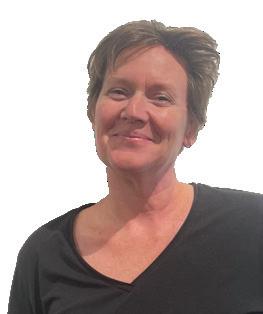
More than a sound, a style, a specific
beat: hip-hop has an immense range of influences. With cultural roots in Black, Latino, Caribbean youth communities, it has grown into the third most listened to genre globally (PrimeSound).
When hip-hop first found its audience from DJ Herc at a dance bash in the Bronx in 1973, he established a few defining characteristics of the art: an ability to create unconventional rhythms by isolating records and cutting beats short, weaving materials together by using the same or multiple records on a twin turntable, and taking advantage of whatever resources available to create unique sounds.
More broadly these techniques resulted in DJ-ing, rapping, dancing bashing, and graffiting.
Hip-hop has become a critical influence in today’s TV, politics, fashion, and advertising, making American media what it is today.
Whether echoing the pregame warm-up fields, in the airpods of people who are supposed to be listening to teachers, or escaping from antsy cars waiting to exit the Huss parking lot, hip-hop has undoubtedly infiltrated and influenced the SPA
community.
Senior Henry Choi likes that it is a “unique sound” and brings to light a variety of “perspectives.”
1970 Hip-hop first appears in the Bronx
These elements welcomed other styles of dance, poetry, and art forms to work in tandem and become associated with what we call today hip-hop. Along with these elements usually women had been silenced in the sphere of music, but with artists like Salt-N-Pepa that started to change.
History Teacher Andrea Moerer appreciates the “powerful female figures’’ who find their voice in the hip-hop industry. It is a place where “women [can] sort of get involved in that public sphere and
1973 DJ Kool Herc: DJs first block party
1978 Term “rap music” used for first time
be strong figures,” she said.
1983 Salt-N-Pepa: first female rappers
2023 Hip-hop celebrates 50th Anniversary
Though artists like DJ Herc, Run-DMC, LL Cool J, the Beastie Boys have commonly been considered pioneers of hip-hop from the 1970’s, today’s listeners understand the music as J Cole, Kendrick [Lamar], Jay Z, Tupac interpretations.
While other genres of music “tend to be generic lyrics that can be applied to a lot of people’s lives” hip-hop lyrics often “come from personal experiences, ... their lives growing up or their experiences with systemic racism in America,” Choi said.
Senior Humza Murad sees the “lyrics [as] having typically more meaning to them and more ... storytelling.”

[that makes it unique].”
She thinks it’s the rhyming and storytelling from “urban environments” prominent in hip-hop that makes the music distinct.
INFORMATION: prepscholar.com
INFOGRAPHIC: Annika Kim and McKinley Garner
For Moerer, “It’s a combination ... of like rhythm and then spoken word

Hip-hop continues to leave an imprint on listeners in its 50 years of recording.

As the leaves begin to change and the days grow shorter, there’s an anticipation for entertainment enthusiasts. Whether a fan of a gripping TV series or eagerly awaiting the latest blockbuster releases this fall prompts excitement.
Now the top four TV shows and movies that are set to light up screens this fall.

Within the SPA community, a recent poll was conducted to gauge the collective preferences for this year’s cinematic and television offerings. Amongst a wide range of responses, the top choices have emerged as follows: “Gilmore Girls” a heartwarming and witty TV series that follows the close relationship of a mother and daughter. “Five Night at Freddy’s” set to be a horror and suspense film/movie exploring the eerie world of haunted animatronics. “The Nightmare Be-
fore Christmas” (a dark and whimsical stop motion animated film that tells the tale of Jack Skellignton and his plan to take over Christmas). Lastly “One Piece Live Action” (an adaption of an anime that follows the journey of Monkey D. Luffy a pirate in his ultimate search for the one piece treasure).
In the community the top streaming services were as followed with Netflix being the top followed by Hulu and then Prime Video. Each of these platforms offer a unique variety of shows and movies, catering to whatever viewers want.
This season/fall/time of year brings forth a diverse array of new shows and movies, including the highly anticipated second season of Loki, the fourth installment of Sex Education, and Asohka
Furthermore this new season of entertainment prompts bringing together within the family. Howard Huelster said: “Watching Mr. Robot with my dad is a great way to spend time and hangout with him”. So,
get ready for an autumn filled with fantastic screen experiences.
Multiple people from the SPA community have shared their standout fall streaming picks, among them junior Coda Wilson, who has chosen “Ragnarok.” This Norwegian series, available with English dub, is set against Odda, Norway, and follows the journey of a young boy named Mangue who discover he possesses the powers of Thor.” When I was a kid I got very into Greek mythology so seeing Ragnarok piqued my interest to engage with mythology and enjoy a show” stated Wilson
Another student with an autumn streaming selection is Ella Barlow, who has opted for “Your Lie in April.” This anime focuses on the intertwined lives of two musicians and the profound love that unites them.“I really like the art styles and how the show captures the sense of life with its up and down but always trying to find the good,” Barlow said.
I SEE THE LYRICS HAVING TYPICALLY MORE MEANING TO THEM AND MORE ... STORYTELLING.
senior Humza Murad
WOMEN [CAN] ... GET INVOLVED IN THAT PUBLIC SPHERE AND BE STRONG FIGURES.history teacher
Andrea MoererFALL PICKS. A ranking of the top 5 watched shows in the US in the week of August 14 - 20, 2023 on all US streaming platforms: Nielson data. INFORMATION: Nielsen
Alumni and Austen— the creators of this year’s SPA theater season. The three formal productions of the year have been announced, with SPA alumni being the creators of two.
This year’s fall play, Sense and Sensibility is based on the novel by Jane Austen, and adapted by Kate Hamill. The play follows the Dashwood sisters as they navigate the world after their father’s death. US Theater Director Eric Severson said “The agency given to the Dashwood sisters drew me in in an interesting way… I’ve always trusted my gut when I’m reading a script, and this is one I could immediately see in my head.” If interested in being in the Fall play, auditions are on Sept. 19 and 20, with performances on Nov 17 and 18.
The One-Act directed by Mr. Severson this year is entitled “DoomGirl,” and it was written by alumni Emma

The production details a video game designer pitching his idea, whilst the story takes place in the scenes between. The student productions have yet to be decided, but there are ideas in the works.
Those who want to be in the one acts can audition on Nov 30 or Dec 1, with the performance on Jan 26, along with the 2 student-directed one-acts, which have yet to be announced.
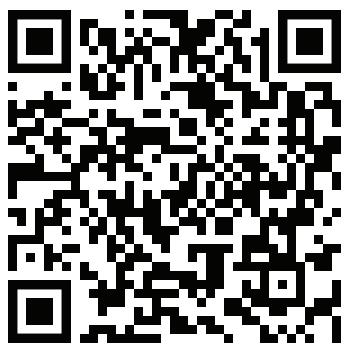
Severson said, “It [DoomGirl] was written by an alumni and directed by a friend of hers their senior year.. I thought it would be fun to do alumn shows.”
Finally, the spring musical, written by US Music Director Tim Kraack, class of ‘05, The Logic Pit. The punk-rock musical takes place in a massive artificial intelligence company, as the employees, who are constantly mistreated, realize there is more to the company than it seems.
Sophomore Lucille Brooks said “I’m most excited to do the Logic Pit, since it was written by Mr Kraack… I just want
to have fun this year.” Those considering auditioning for the musical can do so on Feb 12–13, and will perform on May 17–19.
The excitement and hopes for this year’s season are high, as students and
faculty alike look forward to all that lies ahead.
Senior Andy Wells said “I really enjoyed it [theater] the first time I did, and I made a lot of friends, so I’m really excited for this year. I’m excited.”
however, the process might seem
Knitting is a popular, and supposedly easy, hobby to pick up. Once people get the basics down, it’s possible to make hats, socks, and scarves, but also more fun and decorative items like mug cozies and bookmarks. For complete beginners,

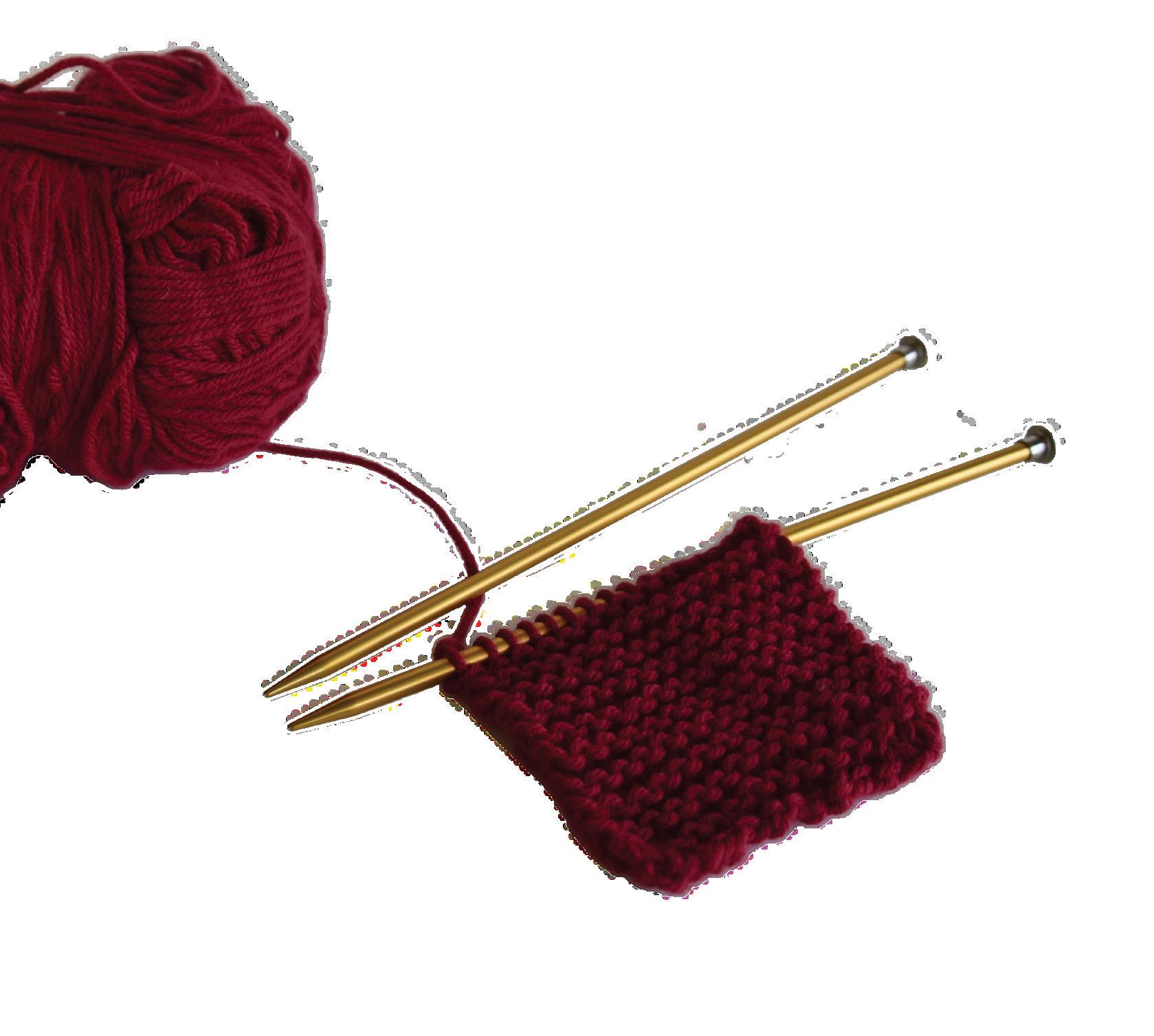

The bare necessities for this project are knitting needles (of any size), a skein or ball of yarn, a pair of scissors, and a tapestry needle. If you’re missing any of those, you’ll need to stop by a craft store or order what you’re missing online. The total cost for this project will be able to stay below $20 if you choose economical options, like simple cotton yarn and bamboo knitting needles. A knitting-specific store in St. Paul is The Yarnery on Selby Avenue, with online ordering available. Although they don’t list tapestry needles on their website, they do offer a darning needle, which would likely work if you’re simply dipping your toes into the knitting world. Just be careful with its sharp point.

AROUND TOWN:
daunting. When faced with a knitting pattern for the first time, full of abbreviations and technical terminology, it’s easy to want to give up — but don’t fret. This DIY will tell you how to make a coaster, step-by-step, with advice from someone who is new to knitting, just like you.
To begin my knitting journey, I followed tutorials from the YouTube channel Sheep & Stitch to

learn the basics. Learning how to put the yarn on the needle and begin my first stitches took about an hour. From there, I used another Nimble Needles tutorial to create a square coaster. After getting started, knitting the coaster took about 30 minutes. Once you know how to knit, this project is incredibly simple.
Begin by casting on 19 stitches. Make sure to leave a tail of 6-8 inches behind. Then, knit across all stitches with the knit stitch for 30 rows. (This process will create a pattern called the garter stitch.) Pro tip: you can check if your coaster is square by folding it in half and seeing how the resulting triangle looks. Once you’ve finished,
read the Arts Feature on Pho Mai at:

PHO FUN. Pho Mai restaurant in Dinky Town Minnesota, Vietnamese cuisine brings delicious food to citizens.
THE RUBICON PHOTO: Carys Hsiung

Disco, outer space, Western, and now glow: past and current homecoming dance themes have dominated September conversation. As the biggest show of school spirit and the first dance of the year, homecoming is a special time for all.

Freshmen Margaret Bonin and Sofia Rivera played a pivotal role in their first high school homecoming by designing themed t-shirts. To get ideas, they looked to the past.
“[We went through] this big stack of homecoming t-shirts that I’ve had from all the years I’ve been at SPA and went through the fonts we liked, the layouts we liked,” Rivera said. “[We compiled] all of those to pick a font and pick a layout, which was honestly really helpful because we could just draw off what we’ve seen before.”
They started their design process in early August. Both Bonin and Rivera enjoy art and realistic drawings, but this was their first experience with graphic design. They went through various rough drafts with initial ideas based on the glow theme: a night sky,

glowing animals, fireflies, and underwater-style designs.
They drew inspiration from the photographic style of bokeh, which Bonin described as “the circles of light in reflections.”
The technique is defined by Nikon as “the effect of a soft out-of-focus background,” characterized by colorful blurred spheres in the background of a photo, almost as if the viewer’s vision was blurred.
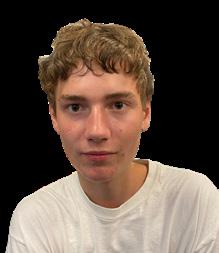
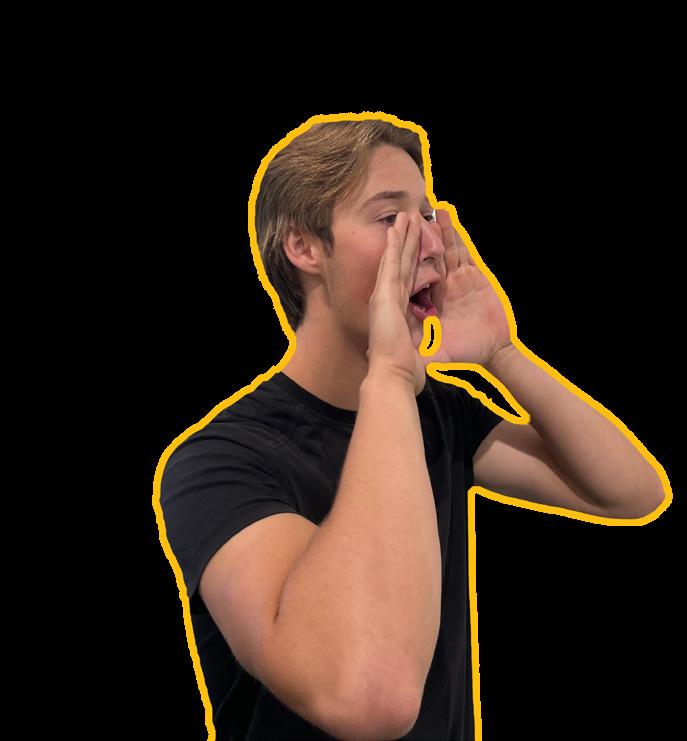
Eventually, the pair combined their ideas into their current design of light reflections and a bokeh-style background. In accordance with the theme of the dance, the t-shirts will glow in the dark.
“It’s fun to do something kind of artsy, a little bit more abstract, but still sticking with the theme,” Rivera said of their final design.
The theme, chosen last year after SAC members voted on a list of brainstormed ideas, provides ample opportunity for unique accessories.
“I’ll probably [wear] glow bracelets ... [and] some glow-in-the-dark nail polish,” Rivera said.
SAC treasurer Natalie Waibel agreed. She likes this theme because of its modernity and versatility.
SHINING STARS. This year’s homecoming shirt design features a glow-inthe-dark logo with stars and bokeh-inspired circles. “It’s fun to do something kind of artsy, ... but still sticking with the theme,” Sofia Rivera said.

SUBMITTED IMAGE:
Sofia Rivera
“You don’t necessarily have to choose an [outfit] with a specific style or specific color ... [anyone] can be a part of it,” she said, citing the glow bracelets as an easy way to participate.
Though she’s served on SAC for three years, co-president Clare Kimmel admitted that she “[hasn’t] actually been to a homecoming dance before,” but hopefully, glow will be the one for her.
Homecoming week will take place the week of Oct. 2, and the Homecoming dance is the night of Oct. 7.

As students gather together in the bleachers, on the field, and by the pool, SPA teams rely on fans to bring the energy. Each team has its own set of cheers, including the schoolwide classic “Spartan Beat.”
People have mistaken homecoming Spartans Henry Hilton and Lukas Hembre for each other since sixth grade. Although they may not look as similar anymore, it’s clear that their connection makes them a great pair to represent the student body at homecoming.
The Spartans are traditionally chosen by members of SAC, who seek students that would successfully raise school spirit and lead the community.
SAC vice president Siri Pattison asked Hilton and Hembre if they were interested in the position and said, “I just think they’re full of positive Spartan energy and that the SPA
that ever since I was a small child, I had seen the Spartan … doing their beat, and I realized that I would too like to be the one leading the beat.”
Hembre was similarly influenced by previous Spartans to lead the community.
“I’ve not researched the Spartan maybe as much as Henry has, but I also did not want to let … our community down, and I’m willing to do whatever it takes to be the best Spartan this school has ever seen,” he said.
Beyond the Spartan’s role as an emblem of school spirit during homecoming, Hilton and Hembre hope to expand the role throughout the school year; for example, by speaking more frequently at assemblies. They also hope to expand the Spartan’s symbolic definition.
Dagney Bruun, an SPA lifer since kindergarten, has fond memories of lower school homecoming celebrations, where seniors go to the lower school and teach them the Spartan beat.
As a junior varsity volleyball player, Bruun also hopes to hear other cheers at her matches.
“I want to do other cheers like ‘ace cheers’ in volleyball,” she said. Bruun will be listening for extra loud cheers for aces and kills at future volleyball matches or maybe Dig Pink.
have two different cheers; one’s called Thunderation and one’s Victory, where each grade will spell out victory,” Meza said.
The team with the most cheers is SPARKS; girls swimming has four cheers that they rely on to get hype.
Alba Markowitz Mulet, a member of the team, said, “We have some of them that we do on the bus beforehand to hype us up and then others during the meets.”
One of them is recited on the bus: “‘One, we are the SPARK’s, two a little bit louder, three, I still can’t hear you, four: more more more!’ and then you keep going,” she said.
“The 500 free is a pretty long event, so we have one while the varsity people are swimming down,” Markowitz Mulet said.
Starting with, “Tooty fruity SPARKs’ booty, watch the SPARKs go down,” Markowitz Mulet explained that each grade level goes down and through all the grades.
community would respond really well to their leadership and enthusiasm.”
One way the Spartan embodies school pride is through their most iconic job: leading the Spartan Beat.
Hilton mentioned that his main inspirations were the Spartans of recent years, but the Spartan Beat also left a significant impression on him as a child.
“Letting someone down is a hard thing to do,” Hilton said. “And when you’re approached and asked [by SAC] … it’s hard to say no, but afterwards, I looked back on it and I realized
“We want to make it clear that the Spartan is not there to represent just the soccer player that scores lots of goals in the homecoming game. We want to represent all of the Spartans [that] aren’t usually represented within the pride of our institution of SPA,” Hilton said. “If you do some random club, you’re still a Spartan representing the school ... and we don’t want you to forget that.”
While the Spartan might be a temporary icon to some students, it also has the potential to symbolize much more. For Hembre and Hilton, ensuring all students are represented equally and spreading “a tsunami of classic Spartan pride and spirit,” as described by Hilton, is their most important mission this year.
Aurelia Meza, captain of the soccer team, said, “I always look forward to the soccer season; it’s a good fun community, and everyone wants to be there and work hard.”
SPA students should celebrate this hard work and bring the cheering up on the sidelines.
“On the bus ride to away games we
Showing some commonality between the pitch and the pool, both the soccer team and the swim team do a victory chant: “‘V-I-C-T-O-R-Y, that’s the SPARK’s battle cry,’ and then one side of the best goes ‘la la la’ and the other goes ‘SPARKs are the best!’” Markowitz Mulet said.
“I’m so excited for homecoming games and other events,” Bruun said.

Hilton and Hembre hope to expand definition and role of “Spartan”
WE WANT TO REPRESENT ALL OF THE SPARTANS [THAT] AREN’T USUALLY REPRESENTED.
senior Henry Hilton
“